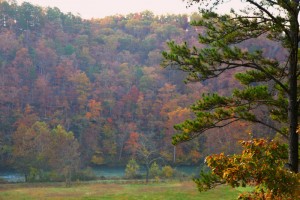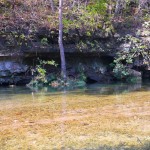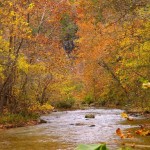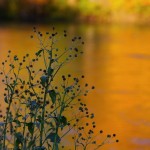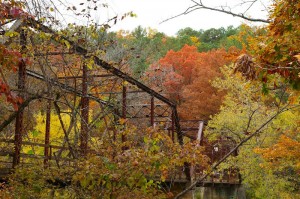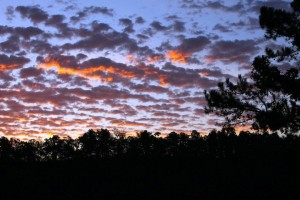
Riveroflife
Posts by :



The beauty of Vera Cruz access on the Bryant Creek
Click on image to enlarge
In the Bryant Creek headwaters, about 30 minutes from River of Life Farm, is the Vera Cruz access. The Bryant cuts a surprisingly deep valley at this point, the bottom is bedrock and the bluffs are beautiful. Try this as side trip sometime. Pictures below are from October 24, 2009.



Autumn on Double Springs (aka. Rainbow Springs)


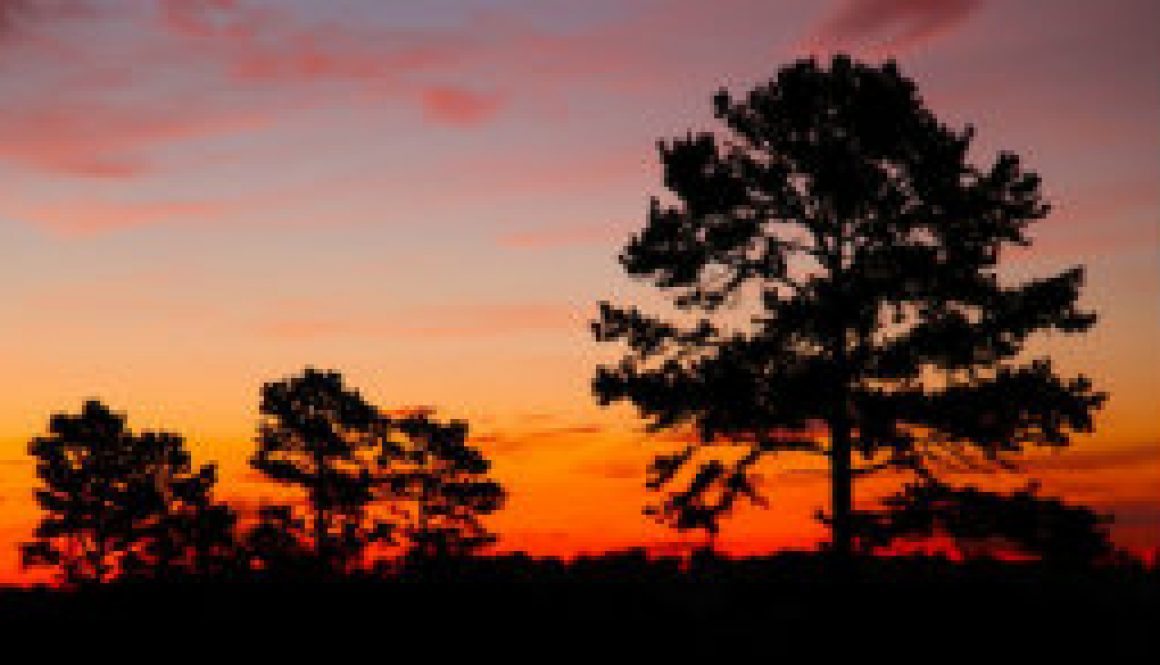

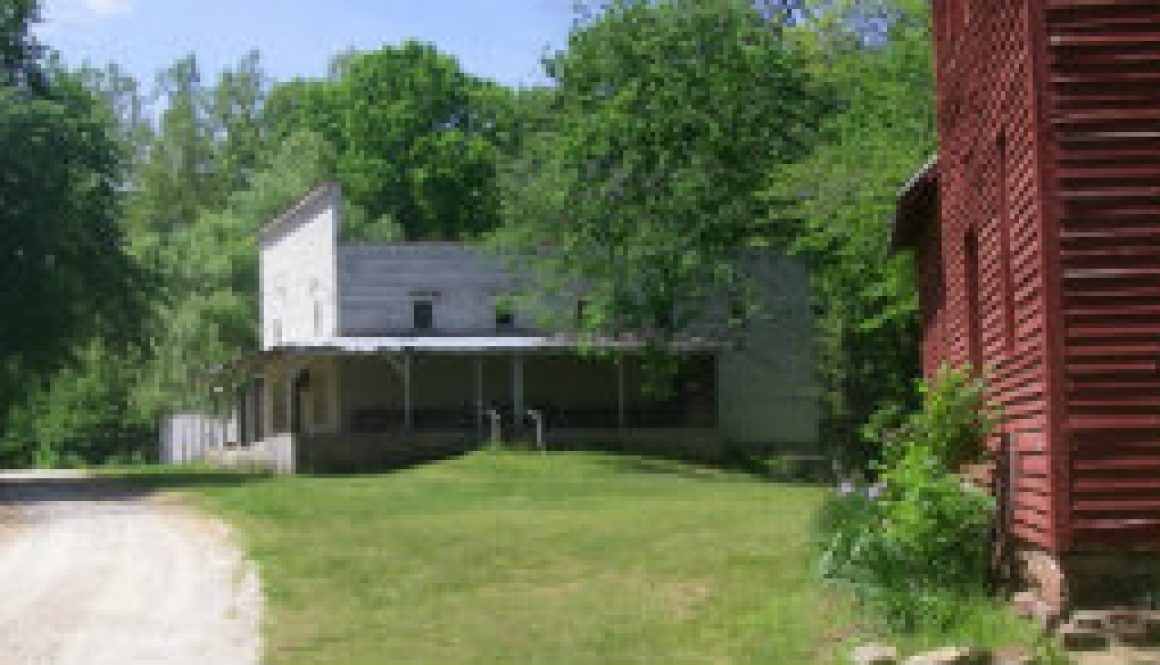
Floating the North Fork in the mid-1960’s PART Three of Five
The second day of our trip started at 1:30 AM with a very scary thunderstorm; with hail and vicious winds. It started with continuous lightening in the western sky about 11:00 PM, by midnight, there was rolling thunder in the distance. By 1:00 AM the lightening became so continuous that it appeared to be only one long lightening flash over the next 20 minutes. I have to admit that I was scared. I had never seen a storm like this one. Storms always appear worse in the country because there is no other noise to grown them out, no lights to minimize the brightness of the lightening, and no radio or TV from which to get updates. Actually, there was no accurate radar in the early 1960’s and even if there was, it would be in Springfield and too far away to see this storm. This storm only got worse. We both became nervous when we heard a swishing and whistling sound off to our south and east; that only lasted a few minutes. The cloud to ground lightening became constant just after the weird noise and then the rain hit. It rained very hard, with hail at times, for the next twenty minutes sand was over. At 4 AM, I could still see the bright lightening in the distant southeast, probably more than one hundred miles away. There a dark star filled sky over us running in all directions but the southeast, where lightening still flickered continuously. I went back to sleep again and did not wake until long after dawn. Steve K was not in the tent but I could smell his cooking from the Coleman stove. I was hungry but hated the cleanup duty that I was about the get.
While I cleaned up up the greasy skillet and utensils; Steve K packed everything up, but we left the tent up until the morning sun did a little drying; but we had to pack it up damp, which is not good. the Old Town was loaded up, this time, with our gear for up to 10 days. We spent about ten minutes cleaning up and policing the campsite and planning the day as we walked and talked to each other. We had hoped to make it to the ghost town of Topaz, with a map wheel on a 1934 contour map, it appeared to be about 5-6 miles, but honestly, we did not know what to expect. I could not find anyone to talk with that had ever floated this stretch of river. It was 9 AM and time to shove off. The river was still clear after the night time storm, but not as clear as yesterday and appeared to have risen about 6 inches. This was only a guess, because we had not placed a marker at streams edge; something that we knew to do, and would do every night in the future. Not surprisingly, the river was full of leaves and twigs; enough to make fishing impossible for now, so we concentrated on the river itself. In the morning sunlight, the rivers beauty began to show in full force. Huge sycamores, appeared to be up to 5-6 feet in diameter and the trunks were bright white in the morning sun. The sycamore leaves were still coming out from bud in many places in the canopy; probably due to the rainy, cold spring weather. There were several very large back walnut trees, still showing very small leaves too. I remaindered from years past that they always get their leaves last in the spring and shed them first in the late summer and fall. Behind the tree line the country was still farm country with lots of hayfields and an occasional corns field. we made a slow left hand bend that moved us to a more eastward direction into from the bright morning sun and saw a doe and very young fawn standing in the stream.
WOW, white-tail deer were hard to see in the Ozark highlands as they were still fairly scarce from over harvesting and dog-running. I had seen several in the early 1960’s, but given today’a abundance, it is hard to imagine that I had probably only seen 5 or 6 in my entire life; Steve K a few more. She was nervous and did not stand long for us and rooted her baby back off into the woods. Almost immediately after the deer, we came to a low water crossing, which we did not expect. It did not show up on the old Topographic map or on the arial photo. The bridge was made from wood planks crossed by some braced pilings, and was not the typical hog-trough that we saw in eastern Missouri, but a crude plank bridge, which had be cobbled back together after high water on several occasions. You could tell by the different aged wood spiked into the bridge and the replaced footings and pilings on one side. We stopped there to take a few photos of the crossing and to sit for a while. I determined that we had only floated about half a mile and that was about right; it was 10:30 AM and we were moving slow. There was a very deep hole just downstream from the bridge with two or three large smallmouth bass patrolling the bottom. One appeared to be approximately four pounds or more. Soon, we saw what was going on we were watching the male, fanning a large nest with his tail fin and chasing everything that came near, including other small mouth bass, goggly and sunfish. Our guess was a late spawn or re-spawn due to high water in May. Either way, this fish was serious about protecting his nest, and appeared gaunt and beat up for all his hard work. They are amazing fish.
After about fifteen minutes at he bridge we pushed off again. Now we entered and area of continuous “S” curves with some logs across the river, we new we had to unload and portage but as we begin the unload the canoe we did notice that there were at least 2 dozen living trees down in the river, and splintered and broken all over the next stretch of river, there was asbestos insulation the the tree tops, shingles everywhere, books, check-stubs, and clothing. Then we both got a sick feeling and the same time, this was from 1:30 in the morning, it was a tornado, and it was not far from us. We wondered if anyone was hurt, what we could do, so we stopped and looked at he map and saw there were only two farmhouses west of the damage path and one we could see. Trees were down in the yard but people were milling around. We yelled at them and asked what happened and was anyone was hurt. They waved us on, after saying “twister” and “everyone is alright”. The portage was a long one; maybe 1/4 to 1/2 miles though a muddy hayfield, but we turned it into an double trip and took turns carrying the canoe. In the end, it took about an hour, maybe more, to put the canoe back in a repack it. This was a scene of absolute devastation, nothing left standing for a hundred yards or more and more damage was evident, the further we got from the storm path, but this was less severe damage. I still remember today the incredible number of killed songbirds of all species in that hayfield. Several Great Blue Herons lay dead in the field also, also killed the night before. A very sad sight.
After we put in again after completing the portage, and started paddling, we spent much time talking about the tornado, but both had to admit that we were equally captivated by the incredible beauty of this stream. The “S” curves continued, but now we were in an area of dense forest, low bluffs, narrow bottoms, and very dark shade. A Green Heron jumped from the left bank and curved his flight downstream and landed on a snag just above the next bend. Near an area where the sun broke through the tree-cover we saw a large Northern Water Snake and stopped to watch him for a while. He was stalking frogs. We started to see lots of large soft-shell turtles on nearly every log in the river; some over twenty four inches in diameter. This is in the days way before canoeing and shooting turtles with a .22 rifle or pistol was popular. There was also a fair number of Sliders on the logs, sometimes what appeared to be entire families from grandparents to newborns lined up according to age. The water was definitely becoming murky compared to the day before. Ozark terminology for levels of stream clarity have always been funny; muddy, dingy, murky, cloudy, clearing, clear. These are the Actual terms used the the St. Louis Globe Democrat to describe river conditions across the state in every Fridays fishing report. They are in order of least clear to most clear.
Despite our earlier feelings about fishing today, we stopped and put the F.E. Thomas together and lined it up and tied on a red fly with a pearl spinner, tipped with a small fly strip. Steve K would fish, while I worked the charts and looked for the two small creeks we had hoped to explore today, while guiding from the stern. The canoe bounced around a steep “S” curve bend over some big rocks and we had to make an immediate left turn into a fast log filled eddy; small but very deep and with quickly moving water the entire length. Some of the logs were huge and must have been on the bottom for 20 years or more; there was not much left of them. Fish were darting in every direction. We knew we had to find a place to turn the canoe out so Steve K could cast. As soon as I could I found a large rock and eddied out behind it. The bow floated up stream against the moss covered boulder, so that all Steve K had to do was place his foot on top to hold us in place. He made several false casts, to straighten and dry the stiff silk line we were using. I could hear every line nub sliding through the steel guides; finally, when slightly wet, it all worked better. This line would need to be dressed (or greased) tonight after we pitched camp. Three casts later and Steve K had a good fish on; possibly a very good smallmouth bass. After a tough five minute fight, he landed a nice four to five pound channel catfish. Yes, channel catfish, on the North Fork on a fly rod. What a surprise ! Never saw or head of a channel catfish taking a fly but since that day I have seen that happen about a half dozen times more; always a surprise. We gave a short thought to keeping the catfish for dinner; but decided it was too big and we admitted to each other that neither like to clean or eat catfish. During the next half mile, Steve K caught and released about 6 nice bass up to fifteen inches, and 2 dozen big and fat sunfish and goggle-eye; and one black perch (green sunfish) that tipped the hand scale a one pound and seven ounces. We checked our ice supply and kept only two more goggle-eye for future meals. I did not get to fish at all this day, even though I wanted to, but I was really busy with charts and maps and my journal; each time we stopped. Both spring creeks we were supposed to hike, turned out not to be much; other than really intimate and pretty.
After 5:00 PM we made a final right turn and the flume from the old mill at Topaz came into view. We puled left and got out to look at the mill. What a neat place; picture this. An old town with no inhabitants; a main street, still in in fair condition made of Ozark stream gravel. An old barn to the left next to a large spring that is dammed up near the road, the dam makes an impoundment of about a acre of clear water. the water plunges over a wood closure into a long flume spillway, whitewater racing down towards on old red mill wheel. The mill is three stories tall and in fairly good shape but has not been used for probably 50 years, maybe more. One hundred yards down the road is a cool old country store with old style glass topped “fill and flow” gas pumps. Next to the store, another building, which might have been the Topaz post office. Across the old roads are several abandoned homes. The town was simply left as it was 30 or so years ago. A newspaper from 1931 lay in the general store window. No one lives here anymore. Why ? It is so beautiful with stands of shortleaf pines scattered throughout. We spent over an hour looking around town as if in the past century, then decided to push on a mile or so and find a small gravel bar or field to camp in; even though this would have been a great place to stay, we felt a little funny about staying in a ghost town overnight. The mosquitoes were especially nasty this evening and I was looking forward to a tent.
(Note; the town of Topaz still exists in 2009, infect, it is no longer a ghost town. There appears to be about 3-4 families in the valley now and they do take very good care of the old town and have been doing so for some time now.)





